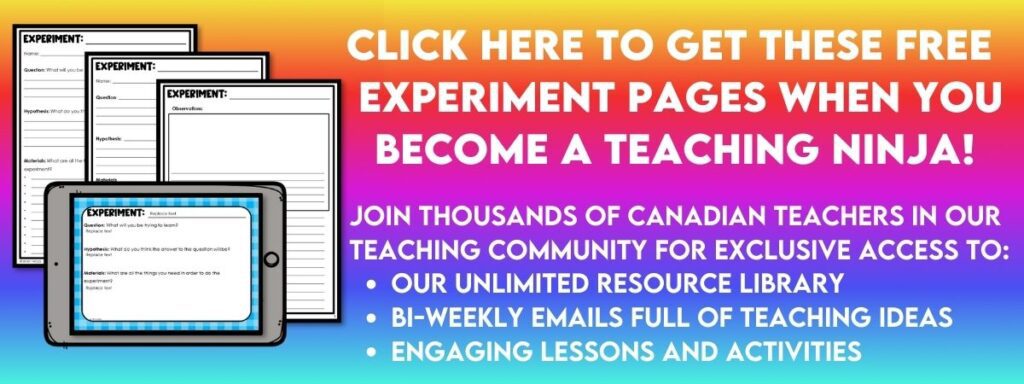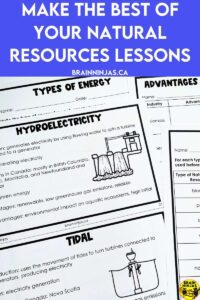
What do you think of when you think of natural resources? Forests? Oil and gas? Wind power? Teaching students about natural resources is easy when you have them examine all the objects around them. Humans rely on natural resources to make life easier. We use them to make shelter, provide energy and sustain our nutrition. Come learn about some of the lessons and activities we use to teach students about natural resources.
Start With a Natural Resources Experiment
Ask your students if they’ve ever eaten rocks for breakfast. They probably haven’t realized it, but many cereals contain rocks or minerals.
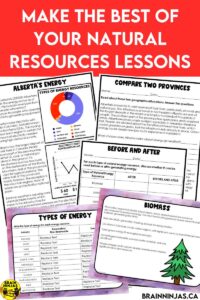
Start by getting a box of cereal with the highest iron content available. Find it far away from the sweet and sugary ones. Generally, you want one with an iron content of more than 20% daily recommended value.
To do this experiment you’ll need the whole box of cereal, a clear plastic bag big enough to hold all the cereal, a strong magnet and a rolling pin.
Ask students to predict if the cereal has rocks in it. Talk about the meaning of a hypothesis when completing an experiment.
Pour the entire box of cereal into the bag. Have students examine it and make observations. Do they see any rocks? Eat a bite of the cereal to show that it’s not poisoned or hard to eat (a hypothesis that arose in our class).
Want some free experiment pages to use with this activity?
Use this set of experiment pages to help organize this experiment. If you’re already on our email list, you can find the experiment pages in the Resource Library. We’ll send them for free when you sign up for our email list.
Close the plastic bag, but leave a small hole for air to remove. Use the rolling pin to crush the cereal into a fine powder. Students can help. Crush it into a fine dust. Slide the magnet over the bag repeatedly and slowly. This might take several passes to collect enough iron. Slide the magnet into a section of the bag where there is no cereal. List the magnet. You should see some small black pieces of dust fall into the clean area of the bag. This is iron.
Ninja Note: Resist the urge to put the magnet directly in the bag. The iron will stick to your magnet forever. Ask one of our students who dropped a magnet into our jar of iron filings. Keep the magnet on the outside of the bag.
Iron is a mineral. Mining digs it out of the earth. Our bodies need iron in our blood to keep us healthy. We get iron from meat or minerals added to processed food. Iron is a natural resource.
Look at the list of ingredients on the cereal box. What other natural resources are in the cereal?
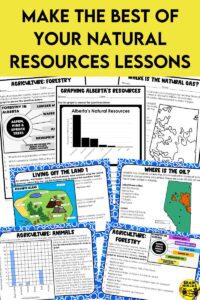
What are natural resources?
We start by teaching students the definition of natural resources. Basically, everything we use in our daily lives incorporates natural resources. Even synthetic items contain raw natural resources.
Define natural resources: materials or substances such as minerals, forests, water, and land that occur in nature and can be used for economic gain. We need resources for survival. Even animals use resources. They hunt for food, so they use resources.
Renewable or Non-Renewable
Renewable resources can be used repeatedly over time. Some of these require sustainable practices. For example, forests are renewable as long as you continue to plant more trees and not overharvest. Other resources like wind power are renewable because there is always more wind.
Non-renewable resources have a limited amount on Earth. Fossil fuels are non-renewable. The deposits of oil, coal and gas below the surface of the earth were created after the extinction of the dinosaurs millions of years ago. There will never be more while humans live on earth.
Examine Different Resources
Look at different resources and how people use them. Farmers grow plants for food and fibres. The plant waste is converted into biomass. Biomass is burned for heat and light and refined into fuels. Biogas and biodiesel can power vehicles.
Students can classify the uses of resources. Do the resources make food? Are they used to build stuff? Are some resources more valuable than others? Why are some resources located in specific geographic areas?
Get Your Planning Done in Minutes
Complete Natural Resources Lesson Plans With Activities and Assessments
If you’re looking for a general lesson about natural resources, we recommend our Natural Resources Lessons and Activities. This resource has been aligned with Grade 5 Alberta Science outcomes but is general enough to be used anywhere in Canada. It covers the definition of natural resources, their uses and whether they are renewable or not. It highlights the energy profile of each province and territory. This resource focuses on the resources but not the extraction or management of resources. It even includes a simple art project to connect your lesson in different modalities. Find it on TpT ($USD) or our BN Shop ($CAN).
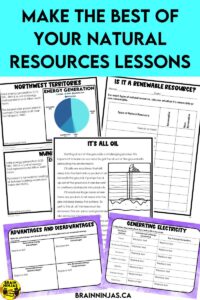
Alberta teachers might find Alberta’s Natural Resources Lessons and Activities better for Grade 4 students. This set of lessons is aligned with the Alberta Science Curriculum. Students will examine maps of Alberta and the locations of some resources. It discusses the resources available in Alberta. Find it on TpT ($USD) or our BN Shop ($CAN).
If you teach Grade 6 in Alberta, Energy Resources Lessons and Activities is perfect for you. It focuses on natural resources used to generate energy. It is general enough for teachers across Canada to use. Students compare fossil fuels and green energy, renewable and non-renewable energy and examine how energy resources are chosen and managed. Find it on TpT ($USD) or our BN Shop ($CAN).
Supporting Activities
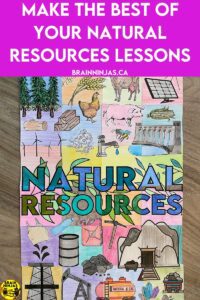
If you’re looking for a general introduction to natural resources, our Natural Resources Collaborative Poster highlights various resources. Our posters include 18, 24 or 36 pieces. You can use them with any sized group. Students colour a piece. Students assemble the pieces into a poster. This poster focuses on renewable and non-renewable resources. Find it on TpT ($USD) or our BN Shop ($CAN).
If you are a teacher in Alberta, we’ve been writing and realigning our resources to work with the new Alberta Science curriculum. Track our progress or find exactly what you need.
Books and Videos You Might Find Helpful
There are many books out there about natural resources.
Canada Close Up: Canada’s Natural Resources by Carrie Gleason
Natural Resources by Christina Earley
How Oil Is Formed by Kristen Rajczak Nelson
Canadian Natural Resources by Sheryl Normandeau
How Natural Gas Is Formed by Ryan Nagelhout
How Precious Metals Form by Julia McDonnell
Using Ocean Resources Sustainably by Natalie Hyde
Discovery Education: Natural Resources
Do You Teach Science?
We have a variety of science posts to help you out.
- How to Shock Your Students With Engaging Electricity Lessons
- How to Leverage Critical Thinking Challenges to Your Advantage
- 10 Engaging Weather Lessons All in One Place
- How to Grow a Healthy Classroom with Plants
- How to Learn About Wetlands Without A Pond
- 15 Simple Machines Activities that Will Hook Your Students
- How to Escalate Your Chemistry Experiments
- Astronomy Lessons That Are Out of This World
- Create These 5 Fantastic Devices That Move
- Foster Environmental Stewardship in the Classroom
- How to Teach Students About the Earth’s Spheres
- How to Teach Human Body Systems to Young Scientists
If you have other resources that you think our ninjas would love to use, tell us about them in the comments below.

